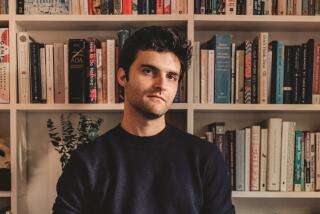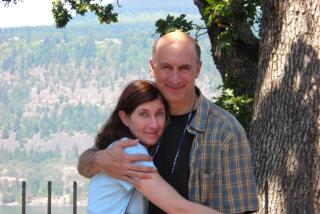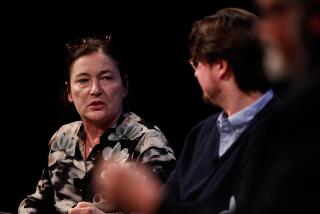A parting glance
Be it foreshowed, be it swift -- death still surprises.
It’s the startling void, the silenced life, that has the weight, the reality.
As custom has it, we ring ourselves around that absence, looking for something to fill it. Not just an explanation or comfort words, a list of achievements or a summing up -- but all that and more.
And that impossible task, says Cyrus M. Copeland, is what the eulogy is for.
In his recent book “Farewell, Godspeed,” Copeland’s hope was to explore the subtle art of the eulogy and remembrance. The word “eulogy,” Copeland says, has a weighted reputation. “People think of it as a sad, lugubrious thing.” However, he adds, great eulogies can -- and should -- do many things. They can inspire laughter and self-evaluation. They rattle on as first-person confessional. They can be as brief as a symbolic snapshot. They can play against type. And for the famous, they can reveal to the world the side -- humanitarian, religious, homebody -- that was never turned toward the camera.
Eulogies are “both art and architecture,” Copeland says. They connect the living and the dead, memory and eternity. “They are a kind of bridge that we build across this deep chasm of loss. And the particular power seeded in those words is often the first step toward healing.”
While a solid eulogy may very well address the essentials -- occupation, partner, kids, a life well lived -- what lends heft and timelessness to a particular remembrance, Copeland notes, is how it conveys one’s essence. The best eulogies, he says, tap something as intangible as one’s presence. They re-create a lingering sense of a soul passed on. In a sense then, they serve as one last visit.
Like so many, Copeland hadn’t given much thought to last rites and the protocol around them. A former New York ad man, he was juggling important blue chip accounts, selling everything from cars to mouthwash. Yet after penning his own father’s eulogy a decade ago, he says he found the process to be both “a pleasure and a privilege.” Sorting through not just dates and achievements, Copeland found himself constructing a multidimensional tribute that became a sculpture, of sorts, in words.
“I just felt very connected to him.” It left him with a germ of an idea: “I thought about putting together a book of eulogies of influential figures who took 15 minutes and stretched them into a lifetime.” But his job and other daily routines pushed it down the “to do” list, so the idea just nested there.
But after the Sept. 11 attacks, Copeland says, “You couldn’t walk past a church without hearing a really poignant tribute or elegiac memorial service, for a policeman or a fireman. It was all about this newfound idea of what an American hero meant. There were the portraits of lives lost in the paper. There were memorials and vigils everywhere.”
Loss felt ceaseless and tangible. And people were searching to somehow make sense of it. He too was already caught up in transition, leaving his blue chip accounts and his fancy expense account lunches to search for something more.
He set to work making lists, writing letters to estate executors, lawyers, the eulogizers themselves. He uncovered hundreds of eulogies that had never been published before.
“I found Fidel Castro’s eulogy to Che Guevara at the bottom of a dusty drawer at the Washington University Library. And I knew the woman who was Bette Davis’ personal assistant when she died. Her memorial service was held on a soundstage. And there were no media and no cameras. But the assistant had kept an audiotape of the eulogy that was given by James Woods. She transcribed it and gave it to me and now it is in the book.”
With 64 in all, Copeland has pieced together a vivid mosaic of memories. There’s cartoonist Cathy Guisewite speaking about Charles M. Schulz; Diane Sawyer on Lucille Ball; Christopher Isherwood on Virginia Woolf; Ossie Davis on Malcolm X.
Madonna on Gianni Versace starts out as we might expect -- “I slept in Gianni Versace’s bed....” but winds up with a particular that is both sweetly unexpected and universal: “I’ve got a pocketful of memories in my Versace jeans. And they’re not going anywhere.”
There is a scatter of memories, just images, that Neil Simon offers up in remembrance of his friend Bob Fosse that humanize the legend. “It isn’t about the accomplishments,” Copeland says. “It’s about those 2 a.m. moments that are filled with vulnerability and poignancy.”
Reaching back more than 100 years, Copeland was particularly struck by how our eulogizing practices and styles have changed. “Circa 1900, the eulogy was a very formal affair -- 90% were delivered by priests or rabbis. Now it’s at 50% and falling,” he says.
There are, he suggests, a couple of reasons for that. “People have seen celebrities like Cher memorialize Sonny and think, ‘I can do that!’ When Diana [Princess of Wales] dies, the world mourns. As well, the American family is in transition and we are not known by our clergy as well as we have been in the past.”
Another key factor, Copeland says, is the baby boomer generation’s general hubris.
“Oh, they are much more self-empowered. If Aunt Mary dies, they are completely unhesitant about getting up at the eleventh hour and singing an aria -- personal, palpable and honest -- to who she was. And what we find, more and more, is that the person who is standing behind the microphone is remembered as well.”
Some unexpected off-shoots to this project have materialized, Copeland says. “I’ve found myself spending some time with the ‘Six Feet Under’ crowd,” he says with a chuckle, as he has been speaking to various regional funeral directors’ organizations across the country about the art of remembrance. “Their concerns are manyfold,” he says: “How long should a eulogy be? How to get somebody who is rambling offstage? How to ease the tension between priests in the Catholic Church and the right of nonclergy to eulogize?”
Lay person or professional, many are cowed by the ritual of remembrance, he says. “But what people have to realize is that mourners aren’t literary critics. What they really want is something real and reflective of the deep nature of this person that we knew.”
While the eulogy is our parting glance in words, it also serves as a device for self-reflection.
“In a way, it does invite a degree of awareness, forcing you to look at who you are, how you live your own life,” Copeland says. “A good eulogy reflects the parts of ourselves we aspire to be.”
More to Read
Sign up for our Book Club newsletter
Get the latest news, events and more from the Los Angeles Times Book Club, and help us get L.A. reading and talking.
You may occasionally receive promotional content from the Los Angeles Times.







